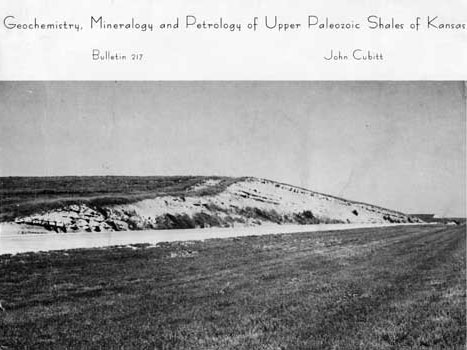The Geochemistry, Mineralogy and Petrology of Upper Paleozoic Shales of Kansas
By John M. Cubitt

Originally published in 1979 as Kansas Geological Survey Bulletin 217. This is, in general, the original text as published. The information has not been updated.
Executive Summary
Upper Pennsylvanian and Lower Permian deposits outcrop along a north-south section in eastern Kansas and underlie all of western Kansas. Within the 2000 feet of limestones, shales, and sandstones that constitute this division of the stratigraphic column are preserved large deposits of oil and gas that have been exploited since the turn of the century. The economic importance of these units has required that a comprehensive understanding of the nature, distribution, and origin of these Upper Paleozoic rocks be obtained. Consequently, detailed stratigraphical, petrological, and paleontological studies of Upper Pennsylvanian and Lower Permian deposits systematically evolved, resulting in the development of the cyclic sedimentation concept by R. C. Moore in the 1930s. This concept revolutionized thoughts and approaches to Upper Paleozoic sediments to the point that by the 1960s cyclic sedimentation was accepted internationally as a frequently occurring sedimentary process.
Nevertheless, results of research did not always support the application of cyclic successions to all sections of the Upper Pennsylvanian and Lower Permian. In particular, lithologies within the Kansas City and Lansing Formations revealed alternations of limestones and shales that contrast markedly with cyclic sequences reported by Moore from the same units. One of the major differences in the results has been attributed to the sampling techniques employed. Moore was primarily concerned with the faunal characteristics of carbonate sediments whereas other workers also examined the lithologies developed in the intervening poorly exposed clastic sediments. Doubt was thus cast on many of the cyclic sequences reported by Moore within the remainder of the Upper Pennsylvanian and Lower Permian. Concern was also expressed that identification and interpretation of subsurface cyclic sequences could now be considered only tentative and the speculated distribution of possible reservoir rocks was open to question. In an attempt to solve some of these questions and provide a set of reference information for later studies, a detailed geochemical, mineralogical, and petrological study of Upper Pennsylvanian and Lower Permian shales was undertaken.
Shale samples were collected from every clastic unit in the Upper Pennsylvanian and Lower Permian with the exception of the Auburn and Winzeler Shales (Wabaunsee Group) and the Seminole Formation (Pleasanton Group). To establish the mineralogical variation within the shales, samples were examined by quantitative X-ray diffraction. Results indicate the presence of quartz, calcite, dolomite, feldspar, chlorite, kaolinite, and illite within the majority of samples with subsidiary proportions of pyrite, gypsum, jarosite, and several expanding clay minerals. The geochemical variation was determined by emission spectrometric analysis of six major oxides and 20 trace elements within the shales. The siting of certain trace elements within the minerals was confirmed using electron spin resonance. Finally, numerous thin sections were made to examine petrological variation within the shales.
Analysis of the multitude of raw data revealed the presence of the following six major clastic facies: (1) a sandstone and siltstone facies corresponding to deltaic deposits, (2) a clayey shale facies corresponding to prodelta marine muds, (3) a black shale facies deposited in reducing conditions, (4) a calcareous grey shale facies that represents open-marine, shallow-water deposition, (5) shale partings in limestones, and (6) red and purple shales common to Lower Permian strata. For ease of interpretation, facies (1) and (2) can be combined to form "outside shales" and (3) and (4) combined to form "inside shales."
Stratigraphically, these facies were found to be distributed in a number of zones.
- In the Pleasanton, Kansas City, and Lansing Groups, there are regular alternations of limestones and inside shales separated into formations by thick beds of deltaic outside shales.
- The succeeding Douglas Group, however, appears to contain only outside shales.
- The Shawnee Group reverts to the limestone-inside shale alternation with outside shales separating limestone formations.
- The Upper Pennsylvanian culminates in the Wabaunsee Group with outside shales and occasional limestones.
- In the Admire, Council Grove, and Chase Groups of the Lower Permian, a general increase in the carbonate content is manifest in the development of calcareous outside shales (red and purple shale facies) separating the alternations of inside shales and limestones. Towards the top of the division evaporites are developed, although the geochemical data showed no evidence for increasing salinity.
Within the Pleasanton, Kansas City, and Shawnee Groups, Fourier analysis of the stratigraphical distribution of quartz, Al2O3, CaO, MnO, Ba, Cr, Ni, Mo, Cu, and Ga indicate the presence of 70-foot cycles in the shales that may be accounted for by orogenic events in the Ouachita foldbelt.
A multivariate statistical analysis elucidated the geochemical and mineralogical evolution of the Upper Pennsylvanian and Lower Permian shales and indicated that the stratigraphical variation in the mineralogical and geochemical data is controlled by nine components--a carbonate component, a black shale component, a clay mineral component, a dolomite component, a shallow versus deep water environment component, a manganese component, and three uninterpretable components. These carbonate and black shale factors may be related to the orogenic controls of outside and inside shales and, similarly, the manganese component is related to marine conditions of the inside shales. The dolomite component indicates that diagenetic activity has affected the shales particularly in the Lower Permian.
In conclusion, therefore, the research conducted has shown that the concept of cyclic sedimentation proposed by Moore is not conclusively supported by mineralogical, geochemical, or petrological data from the Upper Pennsylvanian and Lower Permian shales of Kansas. However, a simplification of the clastic classification to three components--calcareous marine shales, restricted marine black shales, and finally, deltaic and prodeltaic shales, sandstones, and siltstones suggests cycles at approximately 70-foot intervals in the Pleasanton, Kansas City, Lansing, and Shawnee Groups.
Kansas Geological Survey, Geology
Placed on web May 6, 2009; originally published December 1979.
Comments to webadmin@kgs.ku.edu
The URL for this page is http://www.kgs.ku.edu/Publications/Bulletins/217/index.html